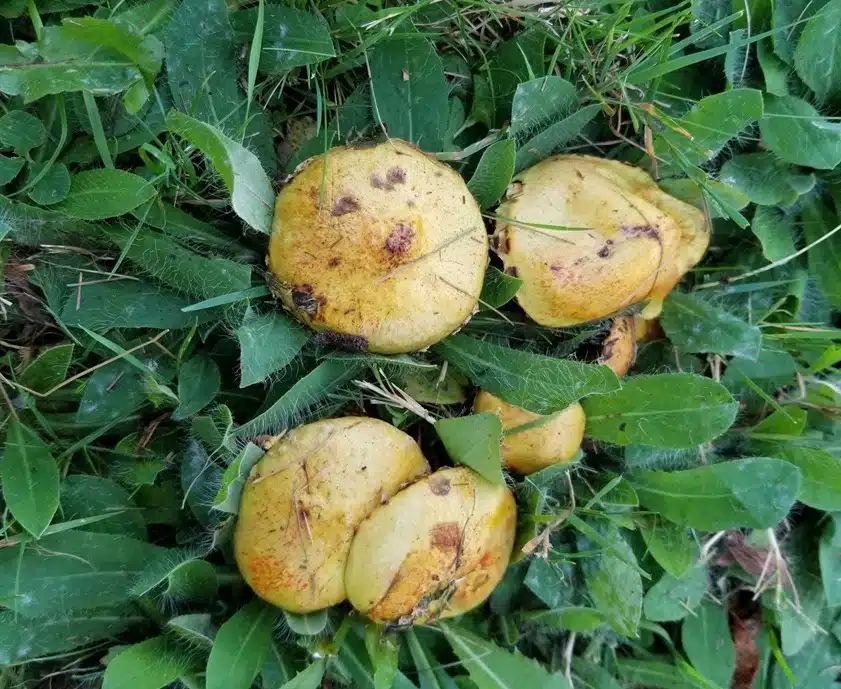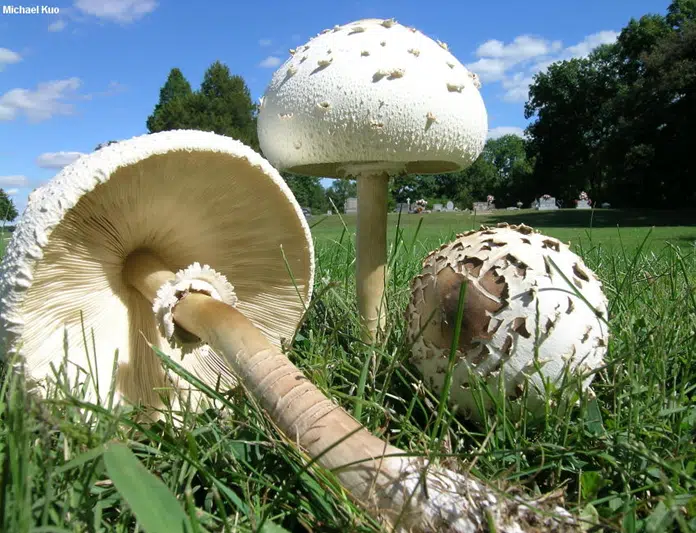
As a scientist at HF&G, I often hear questions like, “How can I get rid of mushrooms in my yard?” or “Is it safe to have mushrooms in my lawn?”. Sometimes, finding information about fungi online can feel like trying to self-diagnose your own medical condition; You may find yourself with more questions than you started with!
Well, have no fear! While some fungi can be harmful to ingest and some may indicate a plant parasite, many are harmless or even beneficial. In fact, nine times out of ten when I’m asked what someone should do about a mushroom in their lawn, my answer is to leave it be. This Mushroom Month I hope to shed some light on the funny fungi and mystical mushrooms that you might see popping up in your yard this fall!
Are the mushrooms on my lawn poisonous?
The primary reason why people are anxious about mushrooms in their lawns is over safety concerns. While there are toxic mushrooms, most are harmless, or could simply cause a stomach ache. Even poisonous mushrooms do not pose a safety risk by simply existing in a yard. Unlike plants, there are no mushrooms that can cause you harm from just touching it. Mushroom poisonings happen when a toxic mushroom is ingested, largely because of a misidentification or by a child or pet. If you have no reason to think that someone is going to eat the mushrooms in your yard, then you have no reason to fear! If you do have young children or curious pets, you may choose to be more selective about which mushrooms you leave alone and which you remove.
Will the mushrooms in my yard hurt my trees or plants?
The second reason why people feel anxious about mushrooms in their yard is because they see them as harmful to plants. While some fungi are plant parasites, many are decomposers which help to cycle organic material back into the soil, or mutualists which help your plants to access the nutrients that they need! If a mushroom in your lawn is parasitic, removing the mushroom alone will not solve the problem; by the time a fungal parasite is producing fruits (mushrooms) the majority of the infection is out of sight, living within the body of the host plant. While a tree can live with fungal parasites for decades, it may be worth calling an arborist to inspect your tree for signs of deterioration especially if it poses a fall risk.
Common Lawn Mushrooms in our Area
While it is true that some fungi are harmful to plants, people, or pets, often mushrooms just get a bad rap! In this article, I will identify a few common fungi that you might see popping up in your yard this fall and will provide notes on their safety and their role in your lawn ecosystem!
Note: This article is not meant to be used for identifying fungi for food or medicine. If that is your intention, I recommend that you seek further information and guidance before taking on that endeavor.
Fuligo septica – Dog vomit slime mold

This bright yellow, puffy substance is not actually a fungus! This is the dog vomit slime mold and it certainly sparks curiosity! Not a charming name, but it’s harmless in a garden beyond aesthetic concerns. In fact, this common slime mold helps to decompose mulch and add organic material into your garden beds. Usually slime molds go away on their own within a handful of days. If you prefer to remove it, you can try gently shoveling it off the top of your mulch. But be aware, spreading spores through disturbance may cause the slime mold to pop up somewhere else!
Phallaceae species – stinkhorns


Stinkhorns may pop up under trees or in garden beds after rain. Like many fungi, their primary role is as decomposers, so they are not harmful to the plants in your yard. While stinkhorns are not considered poisonous they do live up to their name! These fungi spread their spores by producing a strong smell which attracts flies and other insects (many of which may also be pollinators!). There is no reason to remove stinkhorns from your yard unless the smell bothers you!
Bolete species




If you find round, fleshy, mushrooms popping up around your mature trees, pick them up and flip them over! If they have pores (little round holes) instead of gills then they are likely Boletes! These mushrooms are great because they are both safe and beneficial. Very few species within this group are toxic and some are considered edible. More importantly, they form a mutually beneficial relationship with trees, so they are great to have in your yard.
Russula species

These mushrooms are characteristic for their bright white gills and stalk and brightly colored (most often red) caps. Russula species are among the most common beneficial soil fungi that we might see fruiting in our lawns and forests. Like boletes, these mushrooms are the fruiting bodies of beneficial fungi, and are likely helping the trees in your yard to access soil nutrients! Most Russula species are harmless and a few are considered edible. However, those that are can be easily mistaken with species that may cause gastrointestinal distress. These mushrooms should be perfectly safe and even beneficial in your yard!
Armillaria tabescens– the ringless honey mushroom


This is perhaps the most common mushroom that I get questions about in the fall! These outgoing fungi fruit in clusters at the base of mature trees starting in early fall. These fungi are not toxic and are perfectly safe to leave alone if you see them in your yard. However, it is important to note that while these mushrooms alone are not harmful, they are the fruiting bodies of a wood rotting parasitic fungus. While a tree can live with Armillaria for decades, it may be worth calling an arborist to inspect your tree for signs of deterioration.
Note: While the ringless honey mushroom and many other species within this genus are safe to eat, they are easy to mix up with poisonous look-alikes (such as Omphalotus olearius, commonly known as the jack-o’-lantern mushroom).

Chlorophyllum molybdites – the false parasol


The false parasol, or Chlorophyllum molybdites, is one of a few classic “fairy ring” mushrooms which may sprout up in lawns during the fall or spring. Fairy rings form because fungal mycelium, or thread like structures, is growing radially belowground from a central point in the circle. These mushrooms are harmless to your lawn, which is a good thing because it is considered bad luck to destroy a fairy ring! That said, the false parasol is often also called “the vomiter”… and I bet you can imagine why. Poisonings from this mushroom can cause severe gastrointestinal distress, so while you are safe to leave it alone it should not be ingested!
Note: this mushroom has a deadly look-alike, Amanita bisporigera AKA the destroying angel. While the false parasol has brown tissue adorning the cap and stipe, and green spores, the destroying angel is stark white with white spores and does not grow in fairy rings (pictured below).

Photography credits: David Burke, Pam Brown, Michael Kuo, Claudia Bashian-Victoroff, Albert Jackson, Anna Funk, Evgeniya Vlasova

Claudia Bashian-Victoroff, MS
Research Specialist
I am a fungal ecologist focused on connections between soil fungi and tree health. My research couples field collections with modern molecular identification methods to investigate ectomycorrhizal species diversity and function. As a research specialist in Dr. David Burke’s lab at the Holden Arboretum, I support research on soil ecology and forest pathology. Currently, I focus on the role of soil fungi in urban canopy restoration in Cleveland, OH. Trees growing in urbanized environments are subject to pressures such as habitat fragmentation, exposure to heavy metals, and soil compaction. Mycorrhizal fungi can enhance plant growth, disease resistance, and drought tolerance; therefore, it is necessary that we establish a better understanding of how these fungi might improve outcomes of urban restoration efforts. Beyond this, I enjoy discussing the importance of fungal research and conservation with diverse audiences through teaching, writing, and mentorship.













